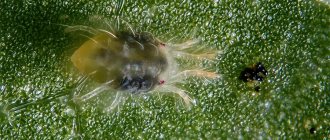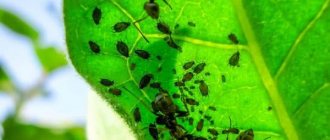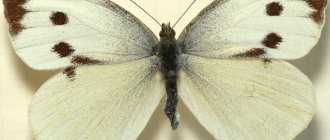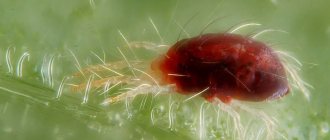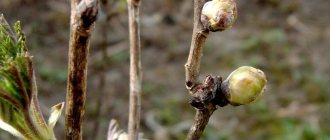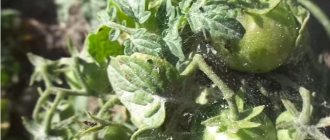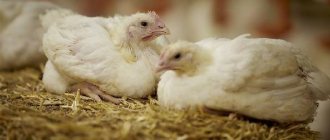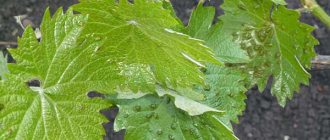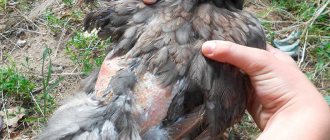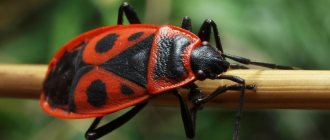Description of the tick
The mealy mite is considered one of the most harmful insects. It not only spoils cereals, seeds, herbs, and food, but can also cause the development of serious human diseases. In order to fight it, it is necessary to study in detail information about the pest.
This is one of the insects that exhibit sexual dimorphism (differences in the appearance of the female and the male). The male individual has a body length of no more than 0.43 mm, so it is quite difficult to notice with the naked eye. The main distinguishing feature of males is their thickened front legs, which have a conical tooth. The female mealy mite is approximately one and a half times larger than the male. The length of the female’s almost colorless body can reach 0.67 mm. The head of such an insect is pale brown, and the legs are yellowish.
The body of both individuals of the grain mite has a slight rounding at the end. There are 4 pairs of legs on it, each having approximately the same length. They have microscopic suction cups that help the insect stay on the plant.
Brief introduction
These are very small creatures, difficult to distinguish with the naked eye: their body length is from 0.2 to 0.5 mm. The barn tick has an oval body with a smooth and thin shell of a whitish color, which is almost transparent. Through it you can see the fat reserves accumulated by the arthropod during its life. Under a microscope, dark legs and jaws are clearly visible against the background of a light body in most species.
Barn mites are known primarily as malicious pests that live in human supplies and destroy them. The scale of infection can be different: arthropods settle in huge elevators and in jars of flour in an ordinary kitchen.
Stages of development
The entire pest development cycle can take about 2 weeks. During this time, the born insect turns into an adult, which is capable of mating and laying eggs.
The life cycle of such a tick begins with mating. This whole process is quite lengthy and takes several hours. During it, you can observe a “mating walk”, in which a larger female leads a backing male. As soon as fertilization occurs, individuals move away from each other.
The development cycle of an individual mealy mite:
- Egg. A few days after mating, the female begins to lay 3 or 4 eggs per day. In most cases, the laying place is grass seeds and various grains. If there are none nearby, then the female scatters the eggs on food. Over a full season, a female is capable of laying from 20 to 150 eggs. This large difference is due to the presence of different environmental conditions. As a rule, the incubation period lasts 3-4 days.
- Larva. She emerges from the egg looking very much like her parents. The only difference from an adult is the presence of only three pairs of legs. The larvae grow in size very quickly as they continuously eat available food. After about three days, the developing insect becomes motionless. It stays in this state for 1-2 days, and then reincarnation occurs. The protective layer of skin on the back breaks and the insect moves on to the next stage of development.
- Nymph. The duration of this stage is 7 days. At this time, the individual continues to actively feed, and then goes into a stationary state. The result of this process is the appearance of an adult.
Article information
Category: Food selection and storage
In other languages:
English: Get Rid of and Prevent Flour Mites, Italiano: Prevenire o Eliminare gli Acari della Farina, Español: eliminar y prevenir los ácaros de la harina, Deutsch: Mehlmilben loswerden und vermeiden, Português: Evitar e Eliminar Ácaros da Farinha, Français: éliminer et prévenir l',infestation des mites de blé, Čeština: Jak se zbavit roztočů moučných a zabránit jejich výskytu, Bahasa Indonesia: Membasmi dan Mencegah Tungau Tepung, Nederlands: Stofluizen bestrijden en op afstand houden, العربي ة: التخلص من سوس الدقيق ومنعه من البقاء , Tiếng Việt: Loại bỏ và ngăn ngừa mạt bột mì, 中文: 消灭和预防粉螨, ไทย: กำจัดและป้ Acarus siro
- Seal
- Edit
This page has been viewed 9992 times.
Was this article helpful?
Not really
Habitat and diet
The flour mite is perfectly adapted to life in various conditions. It can easily tolerate extremely low or high temperatures. The same applies to laid eggs, which do not die at temperatures ranging from -5 to +60 degrees Celsius.
The grain mite can settle in the following places:
- warehouses where grain crops are stored;
- accumulations of straw;
- haystacks;
- livestock habitats;
- bakeries and other places where flour is stored;
- burrows of rodents and other small animals;
- plant remains (accumulation of autumn leaves, waste from wheat and other crops);
- cereal and corn fields;
- grocery stores;
- kitchens in private or multi-storey buildings.
The diet of mealy mites depends on the habitat. Larvae and adults can eat much more than their body weight and therefore cause serious damage to agriculture.
They eat the following foods:
- wheat and corn flour;
- flax seeds;
- rice, wheat and other cereals;
- various fruits;
- ground cereal;
- meat;
- compound feed;
- homemade baking;
- smoked meats;
- legumes;
- dried fruits;
- vegetables;
- carrion;
- tobacco;
- conservation.
How to fight
Determining at home that flour is infected with mites is quite simple. With a strong congestion, it appears that it is moving. If you sprinkle flour in a small layer, smooth it out and look at it after 20 minutes, protruding lumps will be noticeable. You can suspect a pest by the characteristic minty smell and the appearance of a brown crust.
Measures to combat flour mites at home come down to disposal of spoiled product, disinfection of all containers, kitchen utensils, and furniture. Food about which doubts arise is subjected to freezing for a week or roasting in an oven at a temperature not lower than +60° C.
On an industrial scale, grain is cooled or heated to kill the mite. As a preventive measure, storage facilities are disinfected, disinfestation, fumigation, and contamination control are carried out on an ongoing basis.
Danger to humans and animals
Mealy mites cause many difficulties for workers in the agricultural industry. It eats not only the grown grain, but also young shoots that could produce a new harvest. Affected seeds are difficult to distinguish from good ones, which leads to a significant reduction in yield.
Neighborhood with these pests poses a great danger to domestic animals and humans. This is due to the fact that tick waste products contain many harmful microorganisms, including E. coli.
When a contaminated product enters the body, tick-borne anaphylaxis begins to develop (a severe allergic reaction that can be fatal). It appears within a few minutes after eating.
Main symptoms of the disease:
- severe shortness of breath;
- wet cough;
- anaphylactic shock;
- problems with the digestive and genitourinary systems;
- allergic rashes accompanied by severe itching.
If one or more of these symptoms suddenly appears, you should seek help from a doctor as quickly as possible. They will help determine the cause of the problem and find ways to get rid of it.
Let's sum it up
If we summarize all of the above, we can say that this parasite is very dangerous for humans and we need to get rid of it as quickly as possible. Remember that their reproduction requires special conditions, humidity is especially important, so eliminate this factor indoors. Maintain cleanliness and use safe traditional methods. Don't forget about preventative actions, which are very important.
If the bugs have started, and you could not deal with them yourself, the right thing to do in this case would be to contact specialized services.
Pest control methods
Measures to control and prevent flour mites include a whole range of measures that are aimed at eliminating pests or preventing their occurrence. According to the method of influencing insects, all methods can be divided into 2 categories - physical and chemical.
Physical methods for exterminating grain mites:
- Heat. The pest cannot live for long at temperatures above 60 degrees Celsius. Because of this, the most effective way to get rid of the parasite is to periodically warm the cereals.
- Cooling. During the cold season, the grain storage room should be ventilated several times a day. This will help reduce the temperature to -5, which is fatal for most grain mites.
- Cleaning. At any time of the year, you should regularly sort out the grain. All spoiled and unsuitable for further use grains must be removed from the total mass. This simple action will significantly reduce the likelihood of pest occurrence.
There are several chemical ways to combat grain mites. They are based on spraying cereals with special compounds or treating the premises.
Chemical control methods:
- Products containing hydrogen phosphide (Katfos, Fumifast, Alfos and others). These chemical compounds make it possible to cover grain stocks with a thin film that will kill all pests in 24 hours.
- Special insecticides for ticks (Phostoxin, Fostek). The products are diluted in water and used to spray grain.
- Gas disinfestation. The room in which the grain is stored is treated with gas. It is important to observe the frequency of the procedure so as not to harm the grain.
- Aerosol disinfection. Nowadays, it is quite easy to find the right pest control product. Some are made in spray form, allowing for regular spraying of chemicals in barns. This measure will not only eliminate all insects, but also prevent their reappearance.
- Combined. It involves a combination of two or more methods of combating granary mites.
Alfalfa fall armyworm, or Heliothis viriplaca Hufn.
A butterfly with a wingspan of up to 3.8 cm. The color of the front wings is greenish-gray, the hind wings have a yellowish fringe and a dark spot. The ribbed shape of the egg is distinguished by a cut at the base level. Oviposition is carried out on leaves and stems. Fertility does not exceed 700 eggs.
The egg is initially white in color, which then changes to greenish-yellow or dirty orange. After nine days the larva hatches. The length of the caterpillar reaches 4 cm. The predominant color is light green with dark patches and hairs. Pupation occurs in the soil.
The overwintering pupa is 2 cm long. The main color is reddish-brown with a slight greenish tint. The pest inhabits the forest-steppe and steppe zones of the European part of Russia, as well as the Caucasus, Southern Siberia, Central Asia and the Far East. The flight of butterflies of the first instar begins in May, and of the second instar not earlier than July. The caterpillars parasitize not only flax, soybeans and alfalfa, but can feed on cereals and corn.
Fighting methods:
- sowing flax as early as possible,
- cleaning crops from weeds,
- the use of deep autumn plowing of fields,
- inter-row processing,
- release of Trichograma eggs into the fields.
In case of mass infestation of the pest, insecticides, bacterial and viral preparations should be used.
Preventive actions
In order to avoid the appearance of flour mites, it is necessary to take preventive measures. These simple steps will significantly reduce the risk of grain infection by dermatophages and prevent their rapid reproduction.
For large enterprises
The most important task of large agricultural enterprises in winter is to protect grain reserves that will be used for sowing. If flour mites infest them, most of the grains will lose their ability to grow. This will lead to poor yields and loss of investment.
Necessary measures aimed at combating barn pests:
- Thorough inspection of barns and grain warehouses. Agricultural workers must regularly monitor the condition of the cereals and carry out the necessary checks.
- Spraying containers used for storing and transporting grain with chemicals. If you do not do this, you can create favorable conditions for the development of insects.
- Preparing premises for grain storage. Before storing grains, it is necessary to carry out cleaning and disinfestation. This will not only help get rid of existing pests, but also reduce the risk of their occurrence.
- Manipulations with grain. Before storing it, you need to dry it and remove all impurities.
- Treatment of cereals with chemicals. During storage, grain should be periodically sprayed with insecticides to kill emerging insects.
- Creating unfavorable conditions for the reproduction of flour mites. Regular ventilation and maintaining a certain temperature and humidity will prevent pests from multiplying and destroying the crop.
- Conducting laboratory tests. During long-term storage, it is recommended to frequently check the grain in laboratories. This will help identify not only the insects themselves, but also the microscopic eggs laid.
In a house or apartment
Very often, grain mites can appear in a city apartment or private house. In most cases, this occurs due to improper storage or use of food. In order to avoid the appearance of pests, the following measures should be observed:
- It is not recommended to buy or bring low quality flour into your apartment. Infected flour has a grayish tint and emits an unpleasant odor, and also collects in lumps that do not crumble when touched.
- Be extremely careful with flour and other goods purchased at very low prices. In most cases, such products were stored incorrectly or have expired.
- Mealy mites only appear in large accumulations of cereals and flour. Because of this, it is recommended to buy small quantities of products and store them in an airtight container.
- Products intended for pets (dry food, leftover food) must be kept away from human animals.
- Places where food is accumulated (pantries, kitchen cabinets) should be regularly washed and treated with insecticidal agents.
- Experts advise regularly drying the foods that mealy mites most like to be in (flour, cereals, dried fruits, medicinal herbs).
- Products intended for long-term storage should sometimes be taken out into the cold or placed in the refrigerator. A few tens of minutes will be enough to kill all pests.
- The flour mite is afraid of the smell of bay leaves and garlic. In order to prevent the appearance of this insect, you can put 1 clove or leaf in a container with food.
The flour mite is a harmful insect that can destroy large grain reserves and reduce yields. These pests settle not only in barns, but also in people’s homes, posing a threat of infection with serious diseases. In order not to be afraid of the negative impact of this parasite, it is necessary to follow the recommendations of specialists and carry out preventive measures.
Meadow moth, or Loxostege sticticalis L.
A small butterfly with a wingspan of up to 2.5 cm. The front wings are gray and have a yellowish stripe along the edge. The hind wings have two parallel stripes along the edge.
Oviposition is carried out on weeds, plant residues and soil.
The length of the hatched caterpillar is 3.5 cm. The greenish-gray body has a pronounced dark stripe and sparse islands of short hairs. Caterpillars attach to plants via webs and feed on leaves, buds, ovaries and the epidermis of stems. They overwinter in the surface layer of soil, inside the spider cocoon. Pupation also occurs there.
In spring, the flight of first generation butterflies begins. Affected plants turn yellow and cause insufficient long fiber output.
Control measures:
- destruction of weeds,
- disking and the use of deep autumn plowing,
- use of modern insecticides.
Characteristic
The flour mite, or Acarus siro, belongs to the class of arachnids and is a representative of the order Acariform mites. This is a microscopic pest of grain products, as well as dried fruits, nuts, and sometimes cheese and meat.
It is impossible to examine a flour mite with the naked eye, only with the help of a microscope, as shown in the photo. Its body dimensions are very small: in females - from 0.35 to 0.65 mm, in males - from 0.3 to 0.4 mm. The integument is almost colorless, having a faint white or pale gray tint. The body is divided by a transverse groove, which is located in the area between the second and third pairs of legs, while the front part will be slightly darker than the back.
Habitats
In nature, the flour mite lives where there is an abundance of plant debris, for example, in stacks of straw, heaps of hay, in forest litter, and can also settle in bird nests and rodent burrows. It is often found both in livestock buildings and on agricultural lands where corn, vegetables and grain crops grow.
The spread of flour mites in granaries and other warehouse buildings occurs according to the simplest scheme - the pest gets there with freshly harvested crops, on containers, equipment used in warehouses, and on grain cleaning machines. As a result, the parasite finds itself in optimal conditions for existence that meet all the necessary requirements - there is an abundance of food, suitable humidity and air temperature.
Nutrition
The meal mite's diet may include food such as:
- processed grains, such as flour, bran and animal feed;
- yeast;
- powdered milk;
- mold spores;
- cheese;
- dried vegetables and fruits;
- sausages;
- meat and bone meal;
- fish flour;
- egg powder;
- raw tobacco;
- spices.
Optimal conditions for life and development
The habitats of the flour mite are always warm and humid, since these are the conditions that are most suitable for the rapid development of the population of this pest. The optimal temperature for its normal functioning ranges from +21...27°C, relative humidity 65...80%. At the same time, the moisture content of food products on which this species parasitizes should not be lower than 13%.
On a note! Under such conditions, the female alone is capable of laying about 800 eggs!
This parasite tolerates a temporary drop in temperature relatively easily - when the thermometer drops to -5°C, it can survive for about 18 days. If the temperature rises to +55°C, the flour mite will die after 10 minutes, at +60°C – after 5 minutes.
Under normal conditions, the full life cycle of the parasite takes about 14 days, but despite the relatively short life span, the colony grows quite quickly. Overpopulation pushes flour mites to search for other food sources, and often this process is quite noticeable without the use of auxiliary equipment - a dust-like layer consisting of tiny mites seems to flow over the surface of shelves or bags of food.
